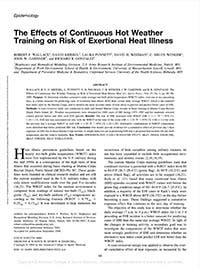
ATHLETIC HEAT STRESS RESEARCH
Effect of WBGT Index Measurement Location on Heat Stress Category Classification
Differences in WBGT index along 23 km of the Boston Marathon race route can be small enough to warrant single measurements. However, significant misclassification of flag categories occurred using WBGT estimates for meteorological stations; thus, local measurements are preferred. If the relation between station WBGT forecasts and the race sites can be established, the forecast WBGT values could be corrected to give advanced warning of approximate flag conditions. Similar work is proposed for other venues to improve heat stress monitoring.
The Heat Strain of Various Athletic Surfaces: A Comparison Between Observed and Modeled Wet-Bulb Globe Temperatures
The National Athletic Trainers’ Association recom- mends using onsite wet-bulb globe temperature (WBGT) measurement to determine whether to modify or cancel physical activity. However, not all practitioners do so and instead they may rely on the National Weather Service (NWS) to monitor weather conditions.
Roundtable on Preseason Heat Safety in Secondary School Athletics: Environmental Monitoring During Activities in the Heat
To develop best-practice recommendations us- ing thermal indices to determine work-to-rest ratios and facilitate further implementation of environmental monitoring for heat safety in secondary school athletics in the United States.
The Effects of Continuous Hot Weather Training on Risk of Exertional Heat Illness
Our results provide evidence for a cumulative effect of previous day’s heat exposure on EHI risk in these Marine Corps recruits. A simple index for use in predicting EHI risk is proposed that includes the dry-bulb temperature and the relative humidity.




